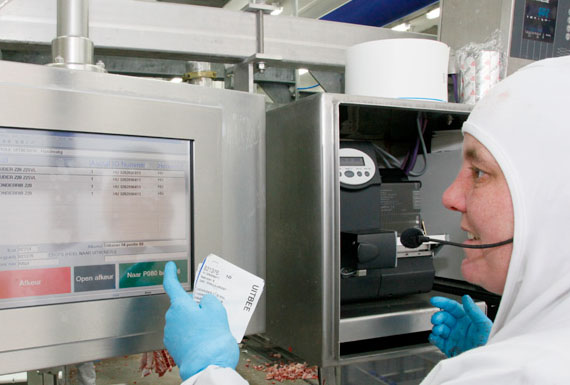The warehouse is where all the orders come together and are stacked onto pallets by logistics staff. The pallets are then shipped to the relevant customers.
Deboning

From the holders, the carcasses are taken to the deboning hall to separate the meat from the bones.The carcass is then processed further.
The entire deboning process is subject to food safety procedures as stipulated in the handbooks. The Netherlands Food and Consumer Product Safety Authority (VWA) checks whether all the rules and regulations have been adhered to. The employees who carry out the deboning process have all received special training and are properly qualified.
In the photograph’s foreground, you can see the back of an employee who is removing a hipbone from a hanging carcass. This used to be done on a table, and removing the hipbone was very hard work. Nowadays, automation lends a helping hand, and the employee no longer has to lift and manoeuvre the carcass to remove the bone. Instead, it is simply a question of placing a hook behind the hipbone and letting the machine slowly pull it out. The employee trims the meat away at the same time to produce a nice, clean bone.
Deboning
Deboning band
Deboning & customer orders
Deboning

The employees are deboning specialists. Working at their own pace, they carefully separate the meat from the bone. The deboned veal then carries on to the next stage of the process. The bones are sent to bone processing plants for use in industrial applications.
Customer order

After deboning, the customer order is attached to the meat. That way, the trimmers – in other words, the staff who convert the meat into smaller and more manageable pieces – know which cuts of meat are required.
Trimmers

The trimmers receive the large pieces of meat with a cutting order attached. The order indicates precisely how they need to slice the meat. This is called a customer-specific cutting process.
Label

All samples receive a unique code in order to keep records straight. The laboratory has a large storeroom full of samples of raw materials and final products, since all samples need to be kept for 9 months. If it should emerge that there is a problem with the feed within that timeframe, the cause of the problem is usually soon identified. If necessary, another independent laboratory will subject the stored sample material to counter-analysis.
When it comes to food safety, the veal sector leaves nothing to chance.
customer-specific
Vacuum-packing
Vacuum-packing

Large industrial vacuum-packing machines ensure that the veal is vacuum-packed under optimum conditions. Naturally, the tracing label is included in the pack too. This enables the customer to trace the veal right back to its point of origin. Each individual calf’s unique ear number is shown on the label.
This number can be used to identify where the calf was slaughtered, where it was raised, what type of feed it received, which certificates were awarded to the calf by the SKV, etc.
Packing

The necessary quantities of vacuum-packed pieces of veal are packed together in accordance with the customer order. Once again, the customer can indicate specific requirements so that the veal is packed precisely in line with the client's needs – in a crate, plain box, company-branded box or in the customer's own packaging, for example.
Warehouse
This is the end of the tour Deboning. Choose another link in the chain or use the red arrow on the right to navigate back to the floor plan.